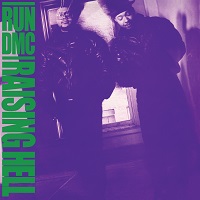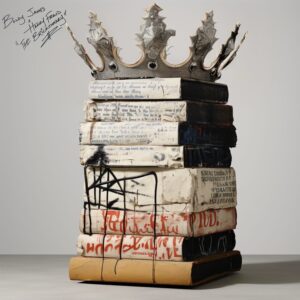
RUN-DMC
Up until Raising Hell, the rap juggernaut we know as Run-DMC was still in its building and breaking-down- doors phase. In 1986 that changed, and in a dramatic way. With their third long-player, the group had reached the mountaintop. It was THE record that proved hip-hop wasn’t a fad.
Raising Hell marked an important and significant new era for the group. Leaving producer Larry Smith for up-and- coming sonic innovator Rick Rubin (still co-produced by Run’s brother Russell Simmons), they began to fully transition not only their own sound, but the sound of the entire genre. Less live playing – with some exceptions – and a slicker, tighter sonic attack. Musical aesthetics aside, though, at their core they stayed true to the essence of hip-hop: two turntables and a microphone, or two.

It’s impossible to talk about the album without its worldwide smash, “Walk This Way,” which hit #4 on the Billboard pop charts and saw the group digging in the rock crates to summon Aerosmith in the flesh, combining Steven Tyler’s and Joe Perry’s musicianship with the group’s own take on the ‘70s classic. The song’s video cemented Run-DMC as legit MTV idols, and both groups rode its wave to new heights.
Beyond “Walk This Way,” the platter is full to the hilt with undeniable classic singles: “You Be Illin’”; “It’s Tricky”; “Peter Piper” and the fashion-world shifting “My Adidas.” Each song was new proof that Run-DMC’s sound was indeed new, but still familiar, and full of the energy, charisma and innovation that drew fans to their first two LPs.

Aside from the singles, the reason the album stands up so well is the fact that there is virtually no filler. “Proud To Be Black” remains a pioneering and underrated cut when people talk about “conscious” hip-hop. And to make sure they never lost the streets that gave them their start, “Hit It Run,” “Son Of Byford,” “Is It Live” and “Perfection” all bring it back to the group’s early days in the park.
Besides the triple platinum status the album achieved, it was more than just a pop smash. It signaled a new era for rap music, and it was the no-turning- back point for the entire genre. This was the beginning of what we now call the Golden Era, and it still sounds as fresh today as it did three decades ago.
PRESS FOR RAISING HELL
“…if it were just a novelty record, a one-shot fusion of rap and rock, Raising Hell would never have sold three million copies. No, the music was fully realized and thoroughly invigorating, rocking harder and better than any of its rock or rap peers in 1986, and years later, that sense of excitement is still palpable on this towering success story for rap in general and Run-D.M.C. in specific.”
“Working with producer Rick Rubin, the Queens crew made an undeniable album that forced the mainstream to cross over to hip-hop. Run and DMC talked trash over Jam Master Jay’s killer mixology, and they bum-rushed MTV with a vandalistic cover of Aerosmith’s “Walk This Way,” featuring Steven Tyler and Joe Perry.”
– Rolling Stone (500 Greatest Albums Of All Time)
“By 1985, Run-D.M.C. had already established themselves as hip-hop trailblazers with their sophomore album, King of Rock. Just one year later, Rev Run, D.M.C., and Jam Master Jay cemented their legacy with Raising Hell…Raising Hell set a new standard for the burgeoning hip-hop genre.”
“It can be argued that while Raising Hell pushed Run-DMC into the music mainstream, it also ensured that – in America at least – rap and hip-hop became central to fashion, sport and youth politics. More than one glass ceiling lay shattered at the trainer-wearing feet of Run-DMC.”
“Raising Hell stands as a landmark in hip-hop music and hip-hop history. Obviously, being the first hip-hop album to go multiplatinum carries a lot of weight, but it’s easy to reduce the album—and Run-D.M.C., in general—to historical significance while downplaying the musical impact…The sound, approach and look of Raising Hell put them over the top and gave any other ambitious hip-hop artist a roadmap to pop culture greatness.”




